NON-FOOTBALL STORIES 1911
While looking through old documents, it is almost inevitable that the
reader's attention will be drawn from the intended target to other articles.
The reports below were found in old Ardrossan and Saltcoats Heralds, Glasgow
Heralds and minutes of Ardrossan and Saltcoats Town Councils. Although they
have no football content, they may be of interest.
STONE COFFIN FOUND AT ARDROSSAN
A discovery of considerable antiquarian interest has just been made at Ardrossan.
While clearing a quantity of debris from the area enclosed within the ruined
walls of the old church, which stood on the Castle Hill within a stone's throw
of the castle, a number of burgh workmen came upon a stone coffin (shown below),
the lid of which was elaborately carved. When the surrounding earth had been
removed, it was found that the lid was lying aslant of the sarcophagus which
although it still contained a portion of skull and a few scraps of decayed leather,
bore the appearance of having been rifled, probably at some remote date. The
coffin lid bears no inscription. The probability is, says our correspondent,
that the tomb is that of one of the Barons of Ardrossan, the last of whom died
in the fourteenth century. Of the old church on the Hill only the lower parts
of the walls now remain. The building was blown down by a gale in 1691 and was
never rebuilt.

Glasgow
Herald, 9 February 1911
THE
ARDROSSAN SARCOPHAGUS - ICONIC PHOTOGRAPH
The iconic photograph
below must have been taken in late January or early February 1911. Strangely,
perhaps, it was not published in the Ardrossan and Saltcoats Herald.

The
workman in the photo is probably Robert Cook who, it is believed, first noticed
the coffin. Robert was born in Maybole, Ayrshire, in 1856. He became a shoemaker
and married Bessie Stevenson in 1874. They had ten children. In 1907, the family
moved to Ardrossan and lived at 57 Glasgow Street. Robert established a cobbler's
shop in Princes Lane before finding employment with Ardrossan Town Council.
He died in 1931 at 1 Hill Place which is very close to where he found the coffin.
His great grandson, Bob Cook, who emigrated from Ardrossan to Canada in 1957,
said "My parents told me that my great grandfather found the coffin".
DISCOVERY OF A STONE TOMB
AT CASTLE HILL, ARDROSSAN
The excavations being made in connection with the old church on the Castle
Hill, Ardrossan, have laid bare a stone tomb, the lid (shown below) of which
is beautifully sculptured. On the lid being lifted, fragments of bones were
found but the lid was 'agee' when found, any articles the tomb may have contained
having evidently been carried off on some previous occasion. This tomb is close
to the north wall of the church - inside the latter - the head being towards
the west. The lid measures 7 feet 2 inches long, being 2 feet 6 inches wide
at the head and 2 feet 1 inch at the foot. The thickness is 7 inches.
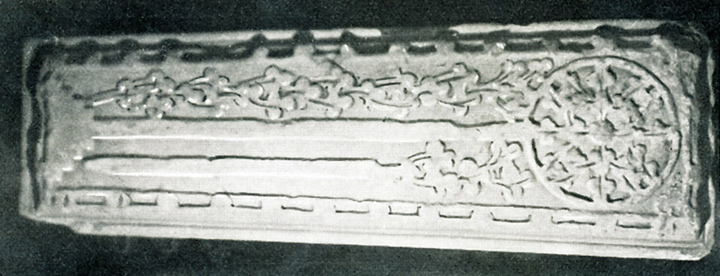
The sculpturing is a bit of
fine workmanship. The centre of the stone is occupied by a cross with a long,
plain, rather narrow shaft, there being four 'steps' on each side of it at the
base. The 'cross' part is placed in a circle 18 inches in diameter and instead
of being composed of a simple cross-piece, has eight spokes radiating from a
central base right out to the circle but if we allow two of the spokes to represent
the shaft, then there will be six radiating spokes. All the spokes are ornamented
with trefoils.
The space between the shaft
and the north edge of the lid is occupied by a straight sword, the point of
which is opposite the second step but does not touch it, the scabbard having
a rope pattern passing along it lengthwise. From the handle of the sword springs
a series of trefoils which extend up to the ornamented circle. The space between
the shaft of the cross and the south edge of the stone is filled in by 22 sprays
of shamrock, the first one springing from one of the steps at the base of the
cross. The north-west corner is filled in with segments of circles and the opposite
corner has been blocked out but remains unfinished. The south side has 13 incisions,
cut sideways, but not all equal in size, while the north edge has 11 oblong
pits or incisions ornamented with trefoils. If the incisions were intended to
be ornamental, those on the north side will answer but so much cannot be said
for those along the south side.
From the above, it will be
seen that the principal features of the ornamentation are the trefoils or shamrocks
but there are no letters or numerals so that we are entirely left to conjecture
as to the date of the tomb as well as the name of the person to whom it was
raised. Saint Patrick is said to have used the clover leaf or shamrock by way
of explaining to the benighted people of these islands how it was possible for
three persons to represent the Godhead and if there is any truth in this legend,
the trefoil ornamentation or sacred subject may have had its origin in this
way. If that is so, the period of the building of the tomb may have been something
between the days of Saint Patrick and the Reformation. The sword evidently indicates
that the person laid to rest he had been a warrior and if there is any faith
to be put in symbols, the rope on the scabbard may indicate that this warrior
was in the habit of going to sea.
Ardrossan
and Saltcoats Herald, 10 February 1911
There are several accounts that give the dimensions
of the coffin. Strangely, in none of them is the height given. Measurement shows
that, including the lid, it is 2 feet 3 inches.
POSSIBLE
OCCUPANTS OF THE SARCOPHAGUS
Public interest in the stone coffin which has been discovered at the old church
on the Castle Hill at Ardrossan shows no sign of waning. Lord (shown below)
and Lady Eglinton paid a visit to the Castle Hill on Friday last (3 February
1911) and, having inspected the coffin, acquiesced in the suggestion that it
should be preserved. So far, it is impossible to guess the age of the sarcophagus
but an experienced antiquarian may be able to throw some light on the subject.
Certainly the person thus entombed must have been an individual of high rank
for the commonality were not buried in stone coffins, much less in coffins richly
ornamented like that found at Ardrossan. It is unfortunate that at some distant
date, the tomb was apparently disturbed for, even if nothing was then removed,
it is obvious that the improper re-fitting of the lid has hastened the decomposition
of the contents. All that the coffin contained when recently uncovered by the
Burgh Surveyor and his assistants was a portion of a skull, a fragment of another
bone and a few scraps of decayed leather. These things, it is to be hoped, will
be carefully preserved for the leather fragment, in particular, may be of assistance
in fixing the probable date of the burial.
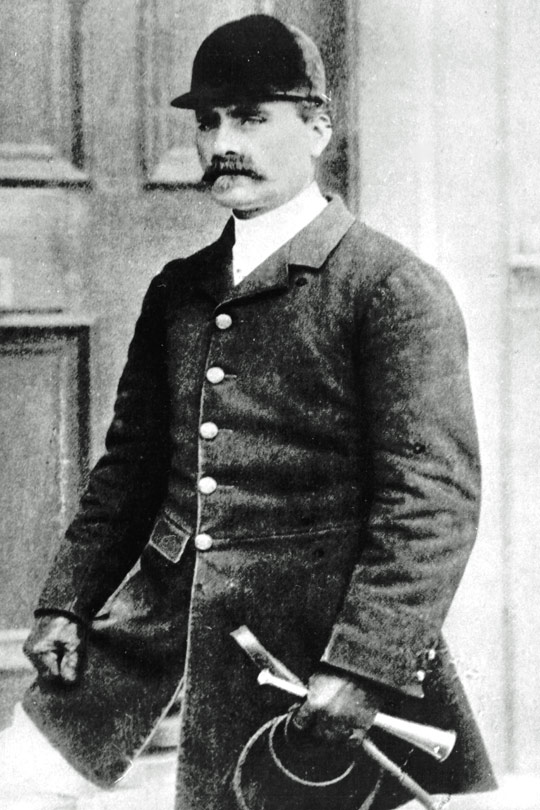
That the tomb has not been disturbed within the memory of living man until the
present time is fairly certain. It is not unlikely, indeed, that no one has
touched it since the close of the seventeenth century when, after the destruction
of the old church by a gale in the year 1691, the stones were removed to help
in the building of the new edifice at Kirkhall. Of course, it is worth remembering
that for long after that, there was no town of Ardrossan and the old graveyard
must have been a desolate spot, providing ample opportunity for working without
molestation to those who may have had any reason to suppose that there was anything
to be gained by opening ancient tombs.
If it is permissible to make a guess at all it is tolerably safe to assume that
the sarcophagus is at least five hundred years old and that it is probably a
great deal older. Stone coffins were much used by the ancient Egyptians and
frequently by the Romans but in this country, they were employed only for the
burial of royalty or of persons of very high rank. The likelihood, therefore,
seems to be that the coffin contained the remains of one of the Barons of Ardrossan,
perhaps of the thirteenth or fourteenth century. The
presence of leather is
the coffin lends support to this theory for it is probable that the aristocracy
of Scotland had ceased to wear leather garments except for very special purposes
by the beginning of the fifteenth century.
The earliest notables of the district of whom there is a historical record were
|
•
|
Arthur de Ardrossan
who, in 1226, was a witness to a charter granted in favour of Hugh Crauford
of the lands of Monach in the parish of Dalry |
|
•
|
Fergus de Ardrossan
who, in 1248, witnessed an agreement between the Bishop of Moray and Friskin
de Moray and who, if the same person, was, in 1250, an arbiter in a dispute
in which the town of Irvine was concerned |
|
•
|
Bryce de Ardrossan
who witnessed charters granted by the Earl of Stratherne in 1268 to 1271 |
|
•
|
Sir Christopher
de Ardrossan who witnessed a charter by Sir Gilchrist More of Rowallan in
1280 |
|
•
|
Godofredus de
Ardrossan who subscribed the Ragman Roll in 1296 |
|
•
|
Fergus de Ardrossan
and |
|
•
|
Robertus, his
brother, who submitted to King Edward I after the surrender of Stirling
Castle in 1304 |
|
•
|
Hugh de Ardrossan
who was subjected to a fine of three years' rent of his estate when Edward
granted an indemnity to the Scots in 1305 |
|
•
|
Sir Fergus de
Ardrossan who was a companion of Robert the Bruce and who was killed in
Ireland in 1316 |
After the last-named came another
|
•
|
Sir Fergus of
Ardrossan, one of the Scottish Barons who addressed the famous letter to
the Pope in 1320, declaring the independence of Scotland |
Then there was
|
•
|
Godfrey of Ardrossan
who, in 1357, witnessed a charter granted by John de Maxwell of the patronage
of the Kirk of Liberton to the Monastery of Kilwinning |
This was probably the last of the Barons of Ardrossan for the Barony passed with
an heir female to Eglinton of Eglinton. The same lady's daughter afterwards married
a Montgomerie of Eaglesham who this became possessed of both the Eglinton and
the Ardrossan estates which have remained in the hands of the Montgomeries ever
since.
Ardrossan
and Saltcoats Herald, 10 February 1911
DISCOVERY OF OLD COFFIN
The Provost
made reference to the discovery in the old burial ground on Castle Hill of a
well-preserved carved stone coffin and stated that Lord Eglinton, who had
visited the Hill, had expressed approval of
the Town Council
taking charge of the coffin and any other
relics which hereafter be discovered.
It was accordingly remitted to the Works
Committee with powers to take such measures as may be found expedient to
preserve the coffin against injury and the action of the weather and place it in
such position about the Hill as may be approved by Lord Eglinton.

Ardrossan
and Saltcoats Herald, 13 February 1911
THE ANCIENT COFFIN
The Burgh Surveyor reported
that the work of repairing the footpaths on the Castle Hill had been continued
during the month.
He had had the soil cleared from the carved
stone found in the old church and the stone was then found to be the lid of a
stone coffin. It had, however, been moved about six inches
out of position, clearly indicating that the tomb had been tampered with.
The coffin was found to contain part of a human
skull, leg bones and some portions of decayed leather. The probable age of
the coffin seemed to be about six hundred years. Lord and Lady Eglinton,
accompanied by Provost Chrystie (shown below left), had visited the place on 3
February. His lordship witnessed the improvements carried
out by the Council and expressed the wish that more excavation might be
undertaken at the Castle.

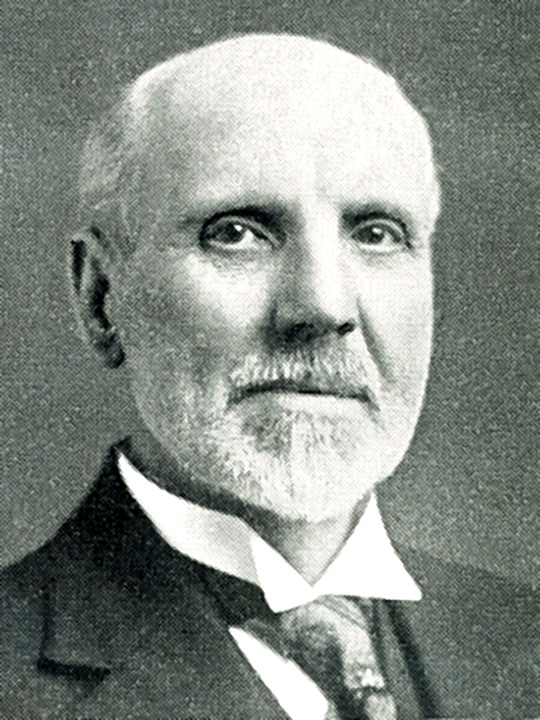
Mr Fawcett (shown above right) said
he would like to know what was to be the next step with regard to the
coffin. He understood a good many people had visited the place
on Sunday and had been disappointed to find the coffin covered up again.
he Provost said “It was covered to protect it
from the weather in the meantime.
Lord Eglinton, I may say, was at one with us in
wishing to have the coffin lifted.
He seemed very pleased with the work which was
done about the Hill and he left it in our hands to do what we thought best with
the coffin and the stone. I would ask the Council to remit this matter to
the Works committee with powers”. Mr Fawcett asked whether nothing more could be done in connection with the
underground chambers in the way of giving something to visitors. He thought a pamphlet might be got up giving
particulars of the Castle and a copy could be handed to visitors to the
underground chambers.
He had been wondering if the convenor of the
Works Committee could not give them a revised edition of Harvey’s Meditation On
The Tombs –
laughter.
Bailie Flynn said they might be on the eve of great
developments in connection with the Castle Hill.
Seeing history was being dug out of the earth
there, he thought Lord Eglinton might assist them in the matter. He had read in the
local paper about a gentleman who was willing to do something in the way of
providing a pamphlet such as had been spoken about and he felt that something
could be made of the historical aspect of the subject.
Mr Syme asked “Could the Surveyor give us any idea as to how long the stone will
last if exposed to the open air?”.
The Provost replied that that was being
enquired into.
Bailie Flinn said “Perhaps the Surveyor would
indicate the probable cost of providing an enclosure for the coffin.
Mr Duncan, the
Surveyor said between £12 and £15.
Mr Inglis said the stone was at present full of moisture as a result of lying in
the soil and if exposed to frost and sun, it would be apt to burst. If covered till April, however, it could be
exposed during the summer when it would dry and become weather-hard, after which
it would be all right.
It was agreed to remit the whole question to the Works
Committee.
Report on Meeting of Ardrossan Town Council on 13 February 1911,
Ardrossan and Saltcoats Herald,
17 February 1911
ARCHAEOLOGICAL FIND AT
ARDROSSAN
As reported in the Herald some days ago, an ancient stone
coffin with a finely carved lid was recently discovered close to one of the
ruined walls of the church on the Castle Hill at Ardrossan.
The discovery has excited a great deal of
interest and
Dr Ross of Edinburgh (shown below left) and Professor Bryce
(shown below right), the eminent
archaeologists, arrived in Ardrossan on
Saturday (18 February 1911) with a view to ascertaining, if possible, the age of
the sarcophagus.


Dr Ross took careful measurements of every part of the tomb, and will report the
result of his investigations at a later stage.
In the course of conversation he declared the
design on the lid to be Early English.
Professor Bryce examined the portion of a
skull which was found in the coffin, and a more perfect skull found close by.
These he stated to be both of the
brachycephalous type, broad and short.
The reports of both gentlemen will be submitted to
the Town Council in due course.
Glasgow Herald, 20 February 1911
STONE COFFIN INVESTIGATIONS
The investigations in connection with the recent
discovery of a carved stone coffin at Ardrossan were advanced a step further on
Saturday (18 February 1911) when Dr Ross and Professor T H Bryce, representing
the Royal Commission on Ancient and Historical Monuments, paid a visit to the
Castle Hill.
Both of these eminent archaeologists were
profoundly interested in the find and, in spite of the torrential rain, spent
fully an hour in an examination of the coffin and its surroundings.
The conditions were far from comfortable.
The downpour had converted the recently
upturned soil about the sarcophagus into a quagmire but even the elderly
Dr Ross (who was 71 years old) appeared to be oblivious of the fact that he was
sometimes ankle-deep in mud so engrossed was he in measuring the coffin and the
coffin lid.
It may be some little time before the official reports of Dr Ross and
Professor Bryce are published
but when they do appear, they will provide most interesting reading.
Meanwhile, we are able to state that Dr Ross
definitely attributes the coffin to the twelfth century.
In this case, the tomb is even older than we
supposed.
Unfortunately, the date of the building of the
Castle is not known but it is probable that it was not very long in existence
before the first records of its inhabitants.
As we stated a few weeks ago, the first known
Baron of Ardrossan was named Barclay and he witnessed a charter in 1140 for the
foundation of the Monastery at Kilwinning.
It is certainly improbable, we should think,
that the Castle was in existence for any great period before that time and,
while there may have been previous Barons in the locality, it is possible that
Barclay who witnessed the Kilwinning charter was really the first, in which case
the coffin may have been his.
In any case,
the fact
that one such coffin has been found naturally suggests the possibility of there
being others.
If the whole area of the ancient church were
dug, some very valuable archaeological discoveries might be made.
It is reasonable to suppose that if one of the
Barons was buried in the church, several of his successors may also have had
there their last resting place.
To be sure, those were wild times and it may
well be that not many of the old Barons died comfortably in their beds or even
near home.
Some were doubtless hurriedly put out of sight
on the field of battle and some may have been drowned.
One of them, Sir
Fergus de Ardrossan, is known to have been killed in battle in Ireland.
Think, for a moment, what must have been the
conditions round about when that stone coffin was laid in its place.
The Castle rock was almost surrounded by the
sea (as shown below in a map from 1769) which, in a southerly breeze, sent its
spray up the crags to the very walls on the south side.
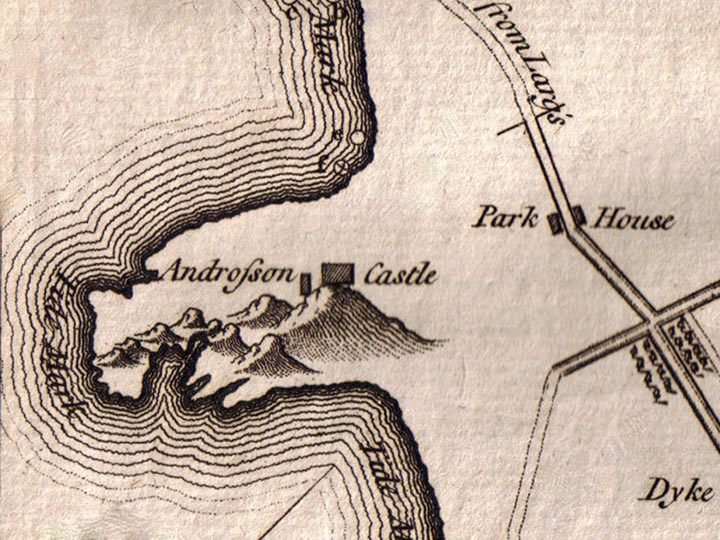
The sea itself in those days was constantly haunted by Norse pirates for the
coffin which was unearthed the other day had doubtless been underground for a
hundred years when King Haco left
his fifteen thousand dead on the fields near Largs (a
reference to the Battle of Largs, fought in 1263).
Inland, the country was densely wooded, there being whole forests stretching
from Dunlop to Darvel and here and there all over Ayrshire.
The Monastery and Abbey at Kilwinning were just
a-building and a little village was springing up, not where the present town of
Kilwinning is, but on the other side of the river.
At Ardrossan, of
course, there were no houses, no habitation of any kind in all likelihood save
those of a few retainers who could not be accommodated within the precincts of
the Castle.
A noteworthy circumstance connected with the discovery
is that the piece of a skull which was found in the coffin and the complete
skull found hard by both indicate their their owners had heads of a similar type
and that a type not common in the west of Scotland.
According to Professor Bryce, who besides
being an archaeologist of note is professor of anatomy at Glasgow University,
they were of the brachycephalous type which means broad and short when viewed
from above, that is, broad from side to side of the head and short from front to
back.
King Robert the Bruce had
such a head but in Scotland, the dolichocephalic or long skull or at least an
intermediate type prodominates.
At the Castle itself, Mr Duncan, the Burgh Surveyor,
had made a further discovery.
A portion of a winding stair has been
unearthed at one corner of what remains of the square tower.
So far as the digging has gone, it seems as if
the stair led down in the direction of the vaults but these, viewed from inside,
reveal no trace of access other than that already known.
Timothy Pont, of course, tells the story about
Wallace’s Larder (the entrance to which is shown below) and how ‘in this deepe
vaulte in ye bottom of ye reade touer flange he ye carcatches of yesse Englich’.
It is possible, therefore, that there may be
another vault situated to the west of the two underground chambers with which we
are already familiar.
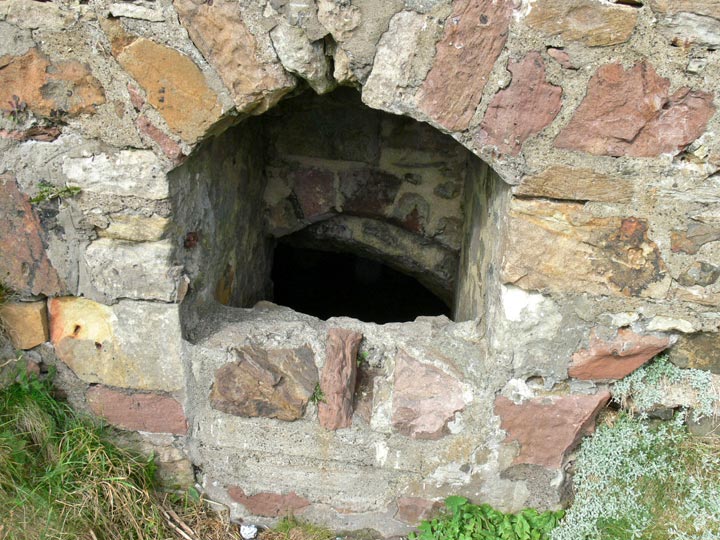
Ardrossan
and Saltcoats Herald, 24 February 1911
STONE COFFIN IN LOCAL MUSEUM?
While opinions may legitimately differ as to the
propriety of retaining the stone coffin recently unearthed in Ardrossan or
removing it to a common centre, there is no question but that its discovery has
directed the attention of outsiders to the town where it was found.
At a gathering in Glasgow on Saturday (25
February 1911) it was a topic of general interest and impression was conveyed by
one and another that the find, for a time at least, will add to the importance
of the town.
If one of the rooms in Kilmahew was set apart
to house curios and an invitation extended to townsfolk here and abroad, to make
contributions, we have no doubt but that a collection of rare interest would
speedily be acquired.
There are natives in every quarter of the world who would gladly enrich a local
museum and there are townspeople with
relics which they might be willing to part with or lend.
This proposal involves no tax and could be
initiated without delay.
Ardrossan
and Saltcoats Herald, 3 March 1911
COUNCIL ACTIONS
RELATING TO THE STONE COFFIN
The Provost reported that Dr Ross and Professor Bryce
as representing the Royal Commission on Ancient Monuments had visited the Hill
and examined the stone coffin and that they had recommended its removal to a
place where it would be protected from the weather.
It
was accordingly agreed that it should be removed to the Burgh Chambers
(in Montgomerie Street as shown below in 1978) and placed in the hall on a
wooden base twelve inches high and painted black.
The Surveyor was instructed to carry out the
removal at the earliest possible date and to employ the necessary skilled labour
in order that the coffin may not be damaged in the course of removal.

The Convenor then
moved that the adoption of the second head of report having reference to the
stone coffin and this was seconded by Councillor Syme.
Bailie McKellar (shown below) moved as an amendment that the coffin should not
be moved from the Hill but placed in position there and suitably protected
and this was seconded by Councillor McKelvie.
On a division, the amendment was not further
supported while the motion was supported by the remaining members excepting
Councillor Inglis who declined to vote.
The
Provost explained that Lord Eglinton approved of having the coffin placed in
Kilmahew and read an interesting
article by Dr Ross and letters from Dr Ross and Professor Bryce bearing on the
ruins on the Hill and the finds there.
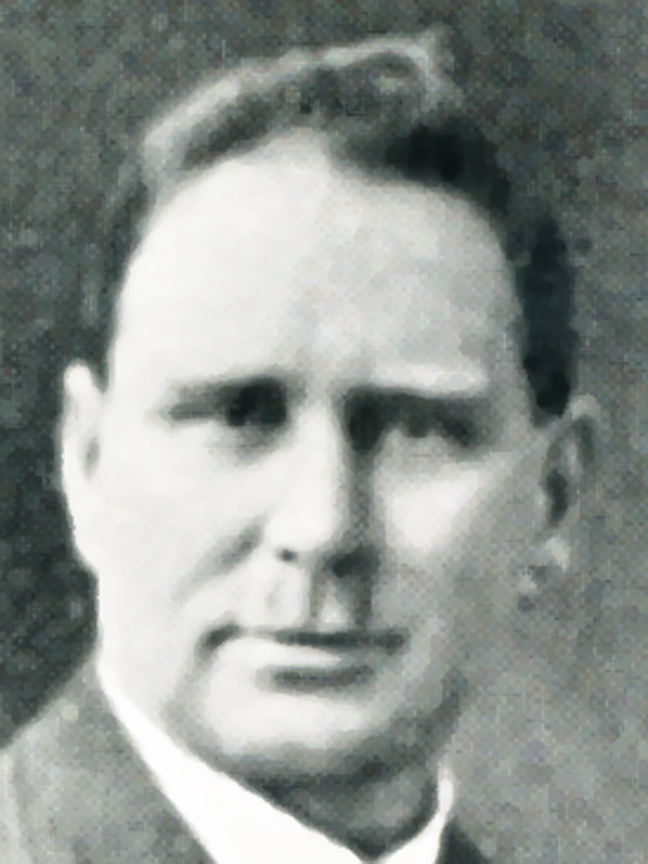
Minutes of the Meeting of Ardrossan
Town Council, 13 March 1911
THE STONE COFFIN
Mr Harvey further reported on the visit of Dr Ross and
Professor Bryce to the Castle Hill and to their recommendation that the stone
coffin found at the old church should be removed to a place of safety for
preservation.
The Committee recommended that the coffin
would be removed to the hall at the Burgh Chambers and there placed upon a
wooden base painted black. The reports of Dr Ross and Professor T H Bryce
will be found in another part of this issue.
Bailie McKellar said he did not know where they had
got their authority to recommend the removal of the coffin to Kilmahew for the
minutes showed that the Committee was instructed to take such steps for the
preservation of the coffin as might be approved by Lord Eglinton and he
understood that his lordship had expressed a wish that the coffin should be
retained on the Hill.
He was very sorry that such a report as they
had just heard from the Works Committee should have been submitted for he
thought the coffin should have been kept where it was.
Of course, they had the opinion of these
experts that exposure to weather would damage it, yet there were stones at the
Castle which had been exposed to the weather for centuries and were apparently
none the worse.
He did not see why the coffin should not be
kept where it was found if it were covered during the winter season and exposed
in the summer.
Nobody would see it in Kilmahew but let them
place it on the Hill and they would have a great many visitors coming to see it,
especially on Sundays.
That stone coffin was a grand asset, one of
the best they had and so he begged them not to remove it from the Hill where it
would be a centre of attraction.
Captain McKelvie supported this view.
He thought the coffin should be kept where it
was found as Lord Eglinton had suggested.
If a cover could be put over it, he would not
remove it.
Provost Chrystie said Lord Eglinton had been
down again since that opinion had been expressed and, after hearing that Dr Ross
had been so strong on having the coffin removed to a dry place of safety, he
concurred in his suggestion that it should be removed to Kilmahew.
Dr Ross had said that it should be removed to
a properly heated place otherwise it would be claimed by the Royal Commission in
London and the Council would not only lose it but would have to pay for its
conveyance to London.
Bailie McKellar said that he coffin belongs to
the Parish.
They could not take it away.
Mr Harvey replied “Oh, no.
The Royal Commission
on Ancient and Historical Monuments have power to take possession of these
things”.
Bailie Flinn said it
might be that they were on the eve of some great developments in connection with
the antiquarian aspect of the Castle and not improbably a small museum might one
day be placed on the top of the Hill in which case, the coffin could be safely
housed there.
It was ultimately agreed that the coffin be removed
to Kilmahew.
Report on Meeting of Ardrossan Town Council on 13
March 1911,
Ardrossan and Saltcoats Herald,
17 March 1911
ANTIQUITIES AT ARDROSSAN
-
EXPERTS’ REPORTS ON COFFIN
AND BONES
Many people will read with interest the reports of the two expert antiquarians
who visited Ardrossan recently in connection with the discovery of a stone
coffin at the Castle Hill.
Dr Ross and Professor Bryce represented the
Royal Commission on Ancient and Historical Monuments Scotland, the former
concerning himself mainly with the coffin and the Castle while the latter, who
is a professor of anatomy in Glasgow University, interested himself in the human
remains.
Dr Ross’s Report
Dr Ross reported that the ruined church is situated about 130 yards north-east
from the Castle near the north end of the ancient burial ground.
This is quite typical of the position of a
mediaeval church with a graveyard where the graveyard extends northwards of such
a church, it will generally be found to be a later extension.
The church, of which all traces were nearly
obliterated, measures about 56 feet 8 inches from east to west by 20 feet from
north to south interior and 64 by 25 feet 6 inches exterior.
This last
measurement is a mistake as the dimension is actually 35 feet 6 inches.
The walls stand to a height of about 4 feet 6 inches above the foundation
and are well built of good large courses.
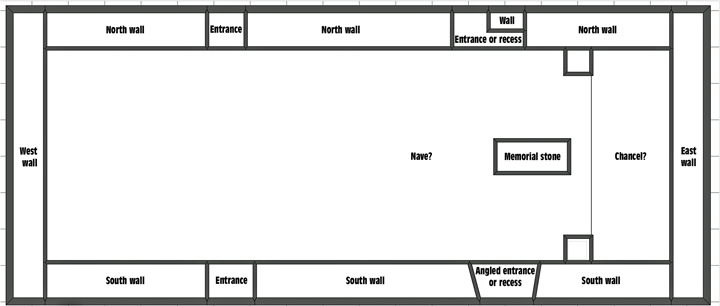
As usual in old churches, there is a north and south door opposite each other
and situated towards the west end (as shown in the above plan drawn by Patrick
Murray).
The north door, 4 feet wide, has three steps
down to the floor.
The remains of only one window exist.
It is 2 feet wide and widely splayed inwards.
This is the only indication of a window
remaining but doubtless, there would be one in each gable.
Possibly there was none in the north wall as
the north side of a church had an evil reputation as we have seen in regard to
the graveyard.
Opposite the window, there is a recess about 6
feet wide in the north wall.
This is the usual position of an Easter
Sepulchre such as exist in Stirling Parish Church, Kinfauns Church, Perthshire,
Saint Giles, Edinburgh and other places.
Here the consecrated host and crucifix were
deposited and a watch set for three days and nights when on Easter morn, they
were removed to the high altar amid much rejoicing and singing Christ Is Risen.
At first I thought this might be a sedilia but
on reflection, I never saw such a seat on the north side of a church and I am
satisfied that is was an Easter Sepulchre and it might also have been a tomb at
the same time as they were often used for the same purpose.
Considerable
portions of the stone pavement remain towards the east end with one step up to
the altar.
I now come to one of the most remarkable and interesting finds made during the
excavations – indeed, I might say made in Scotland in recent years.
This is the discovery of the complete stone
coffin with its lid all in situ.
It stands close to the north wall at a
distance from the west gable of 23 feet 2 inches.
It measures 7 feet long outside and tapers
from the west end, the head, from 2 feet 5 inches to about 2 feet at the east
end.
It is shouldered with a circular cavity for the head
and is 6 feet 4 inches long inside by 12 inches deep and, as is usual, about 1½
inches less in depth at the head which thus, as it were, rested on a pillow.
The coffin was full of earth when I saw it but
there is probably a hole in its floor about the middle.
The
carved lid is, so far as I know, one of the finest things of its kind in
Scotland and is a specimen of mediaeval art at its purest and best period, not
later, I believe than the thirteenth century.
It would not be out
of place in any collection of carved lids to be found in English churches and
cathedrals and the only one in Scotland, so far as I remember, that approaches
it in beauty of design and execution is in the Dudhope Castle Museum, Dundee.
The lid is 7 feet 3 inches long by 9 inches thick and is moulded all round along
the edges with bead and hollow mouldings with a leaf ornament at intervals on
the hollow.
There is a cross in the centre with a circle
at the top, the full width being 19 inches in diameter.
This is filled with carving raised crosswise.
There are five Calvary steps at the foot and
from this there runs up on the dexter side a stem with trefoil-shaped leaves.
On the sinister side, there is a sword with a
mid rib delicately enriched and upwards from the hilt another stem with trefoil
leaves.
There is nothing in the design to differentiate it
from many others of its class.
The
sword indicates the knightly warrior character of the deceased,
at the same time a soldier of the cross.
It is the beauty of the design and its
admirable execution which excite our admiration.
Coffins are by no means uncommon.
They are to be found from early Christian
times and all through the middle ages.
There is and early one at Govan and in Saint
Andrew’s Cathedral, there are some eight of them of the later period.
At Lindores and Cupar Angus and many other
abbeys and churches, they are to be found.
In size, they vary from about 7 feet in length
up to 9 feet 6 inches.
Two very small ones at Lindores measure
respectively 27½ inches by 30½ inches.
There are some nine
coffins lying at Lindores.
In my opinion, the Town Council would be well advised to keep this coffin and
lid and not give it up to any museum nor let it go to any exhibition.
A cast of the lid might be allowed to be
taken.
If the church had been roofed and been in use, the
proper thing would have been to allow it to remain where it was found but as it
was not intended to be exposed to the weather, it should be put under cover in
some public building where it can be seen and properly protected and stand as it
was found.
The position of the church in close proximity to the Castle on the remarkably
rocky knoll which gives the town its name and standing away from and overlooking
the town, suggests that the church was built in connection with the Castle and
for the use of what would then be the small hamlet at the base.
There are similar examples at Dunstaffnage and
Skipness in the west, at Crichton and Borthwick in the east and at other castles
throughout the country and
we may be fairly certain that the stone coffin was
made for some Lord of the Barony of Ardrossan in the thirteenth century.
There does not appear to be much known regarding the history of the church but
that there was a church here in 1226 is shown by an agreement between Walter,
Bishop of Glasgow and John, Abbot of Kilwinning, whereby the Bishop granted to
the Abbot and convent sixteen shillings payable from the Church of Ardrossan in
the Registrum Vetus Ecclesia Glasguensis, the Register of the Church of Glasgow
(opened at folio 48, the very page that details the
agreement).
The convent undertook to provide qualified
chaplains with sufficient sustentation.
I observed a slab lying in the churchyard
evidently to the memory of a priest as it had a chalice carved on it.
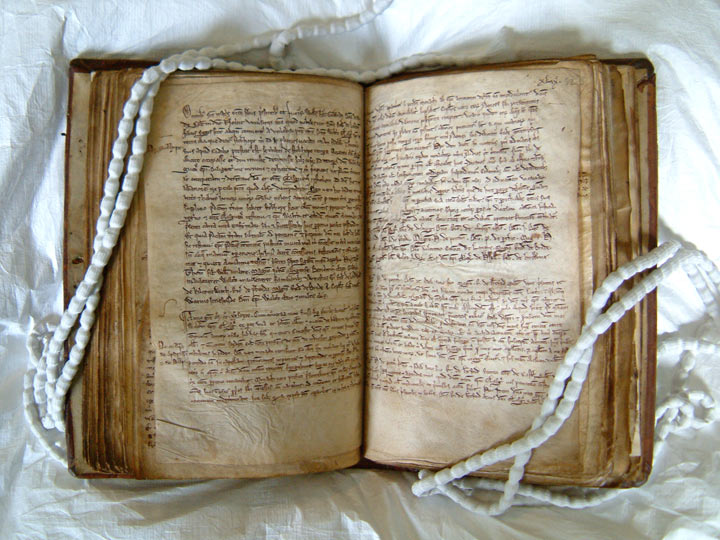
The church was blown down in 1691 by a violent storm.
In all probability, the falling of the roof
wrecked the walls and the building was never repaired.
It was, according to Pont, ‘a goodly parochial
church’.
Timothy Pont (about 1565–1614) was a Scottish
cartographer and topographer and the first person to produce a detailed map of
Scotland. He travelled around the
country creating maps and drawings. The best way of
preserving it would probably be to cement the top of the walls, embedding on
this a course of strong stone pavement having a slight projection and the walls
should be pointed inside and outside but the pointing should not be plastered on
indiscriminately nor brought out to the face of the wall.
On the same day, I also examined the excavations being carried on
at the Castle and was glad to see that the stair leading to the Castle cellars
had been opened up and that another stair leading downwards had been discovered
and it is to be hoped that the Town Council will be able to take such steps as
will enable them to put the building in a state of repair that will ensure its
preservation for many years to come.
The rock has probably been the sire of
stronghold from an early period but the existing ruins appear to belong to the
period of about 1400.
There is a notice of a charter by Alexander,
Lord Montgomery, closed at the Castle of Ardrossan in1468, but I need not pursue
the subject further and only that I am sure the Commissioners will be gratified
to know how keen the interest is that is taken by the Town Council of Ardrossan
in their antiquities.
Professor Bryce’s Report
Dr Ross has asked me to send you some report as to the
bones found in connection with your beautiful sarcophagus.
If the skull found within the coffin was that
of the person originally buried therein, we may gather that he was
a male of
full adult age, probably at least thirty-five.
The bone of a foot indicates that he was a
full average stature.
The skull belongs to the type known as
brachycephalous, that is, broadly oval in shape.
The complete skull found outside the coffin is
of exactly the same type and both differ from the average type of skull found in
the district at the present day.
When I first saw the skull, I thought it
resembled a cast of a skull reputed as that of Robert the Bruce which I have in
my museum.
There is certainly a distinct general
resemblance but the supposed skull of Bruce is larger and heavier and has more
prominent brow ridges.
The two specimens
are of considerable interest to me.
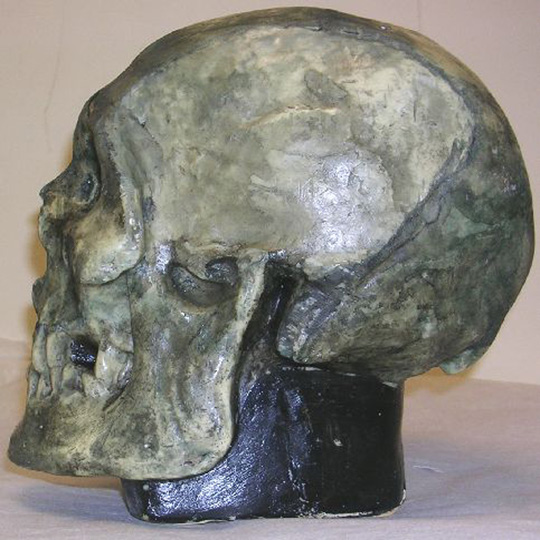

Ardrossan and Saltcoats Herald,
17 March 1911
The photographs above show the plaster cast taken
from the skull of Robert the Bruce referred to in Professor Bryce’s report.
The
skull is on display at The Hunterian Museum, University of Glasgow, with whose
kind permission the photos are reproduced.
BURGH SURVEYOR'S REPORT ON STONE COFFIN
Mr Duncan’s report referred
to the removal of the ancient stone coffin to the Burgh Chambers, a task which
had been satisfactorily carried out.
The interior area of the old church had been
levelled,
covered with ashes
and rolled,
dressed with whin chips
and rolled again.
Report on Meeting of Ardrossan Town Council on 10
April 1911,
Ardrossan and Saltcoats Herald,
14 April 1911
REVISED COPY OF DR
ROSS'S REPORT
The Provost submitted a letter dated 28 April from Dr
Ross, Edinburgh, sending a
revised copy of his report
regarding the Ancient Church and Castle on the Hill and the stone coffin found
there together with the report referred to, in which the services of the Burgh
Surveyor in connection with the matter were acknowledged.
It was agreed to supply Dr Ross with any
information or assistance he may ask for.
Minutes of the Meeting of Ardrossan
Town Council, 8 May 1911
DR ROSS ON THE ANTIQUITIES
The Provost submitted a full report from Dr Ross on
the stone coffin et cetera found at the graveyard on the hill.
The only part different from that already published was an
acknowledgement of the valuable services rendered by Mr Duncan, the Burgh
Surveyor, in assisting Dr Ross in taking measurements on the occasion of his
visit. Dr Ross also reported in
complimentary terms on the care with which the excavations had been carried out
by Mr Duncan and expressed his appreciation of the plans of the Castle, church
and graveyard supplied by the Surveyor.
Report on Meeting of Ardrossan Town Council on 8 May 1911,
Ardrossan and Saltcoats Herald,
12 May 1911
GOSS CHINA
A request by Messrs Arthur Guthrie and
Sons, Ardrossan, for permission to take photographs and measurements of the
stone coffin for the purpose of reproduction in Goss China was granted.
Minutes of the Meeting of Ardrossan Town Council on 12 June 1911
As far as is known, no
Goss China reproductions were made.
Goss Crested China was typically small
white glazed porcelain models, sold as souvenirs.
COFFIN WAS FOUND UNDER FLOOR OF CHURCH
The old church,
under the
stone floor of which the carved coffin was found,
was blown down by a hurricane in 1691, and until 1910,
the ruins were hidden by a dense undergrowth of grass.

The
Castle of Ardrossan published by the Provost,
Magistrates and Town Council of Ardrossan, unknown date but in
or after 1911
If the coffin was found under the floor, it must have been buried to a
considerable depth, considering that its height is 2 feet 3 inches.
ARDROSSAN - THE BEST RESORT FOR
MILLIONAIRES
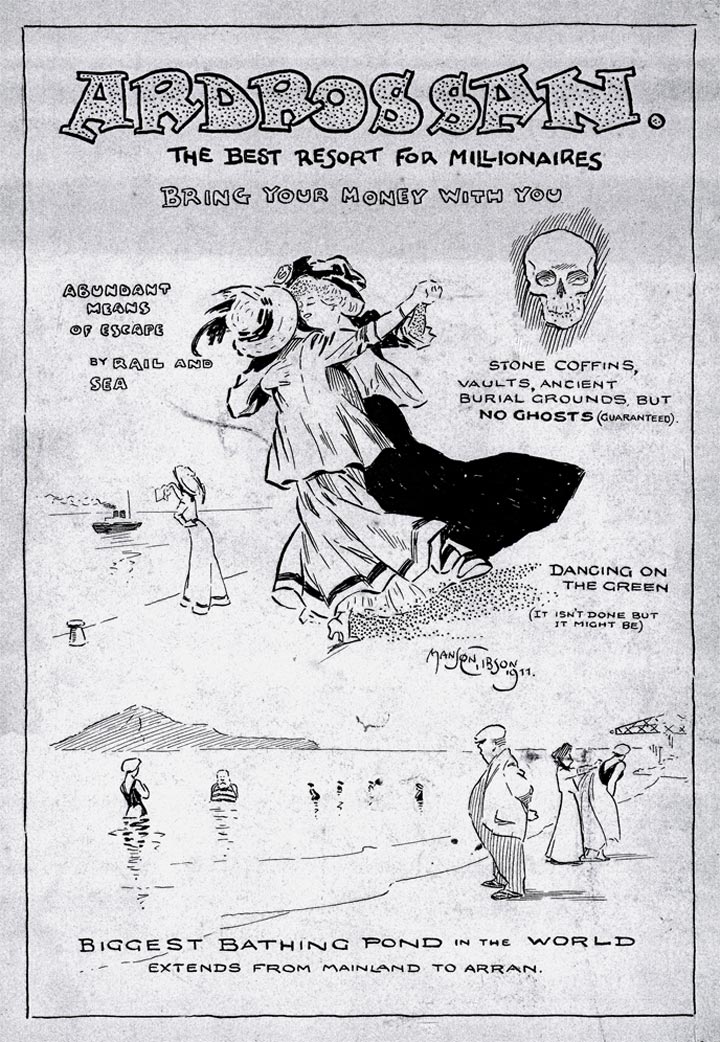
unknown source, 1911
The above advertisement, which makes reference to the stone coffin, was
created by Manson Gibson, an employee of the Ardrossan and Saltcoats Herald.
It could have been an advert or cartoon in the paper or a separate
poster.
VISIT BY THE GLASGOW DISTRICT OF THE SCOTTISH ECCLESIOLOGICAL SOCIETY
An
excursion to Ardrossan by the members of the Glasgow district on Saturday 26
October (1912) was made on a cold and stormy afternoon and expectation was not
as high as to what we were to see but we found a great deal, were most
hospitably received by the Provost, magistrates and clergy of the town and under
the admirable guidance of the energetic Burgh Surveyor, Mr James C Duncan and Mr
P MacGregor Chalmers, all that was there to see was shown to great advantage.
Going first to the ruined Castle high perched on ‘the bank of the promontory’ -
for such is the meaning of the Gaelic name Ardrossan - we saw how much light can
be thrown by intelligent excavation on what was lately a heap of shapeless ruin.
Proceeding
thence to the recently excavated site of the church which served the Castle as
long as that existed and the town’s folk till 1691 when it was wrecked by a
violent storm, we found a long oblong building, its chancel of the same width as
the nave above which it had been raised by three low steps placed at wide
intervals from each other as at Elgin Cathedral.
Considerable
portions of a stone pavement remain and there is a recess which Dr Ross thinks
was an Easter Sepulchre as at Saint Giles, Edinburgh and the old churches of
Stirling, Temple and Kinfaus.
Within this church was recently found, close against
the north wall at a distance from the west gable of 23 feet 2 inches, the
antiquity which was our special attraction to Ardrossan, a stone coffin with its
lid in situ.
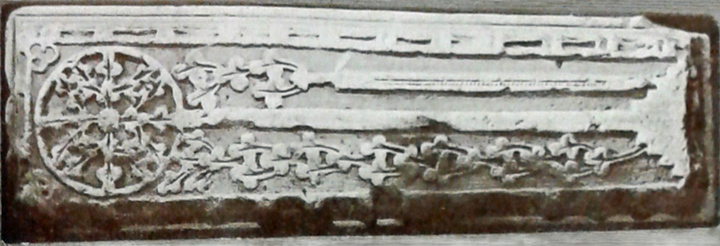
The coffin measures 7 feet long outside and tapers from the west end, the head,
from 2 feet 5 inches to about 2 feet at the east end.
It is shouldered with a circular cavity for
the head and is 6 feet 4 inches long inside by 12 inches deep and, as is usual
in such cases, about 1½ inches less in depth at the head which thus, as it were,
rested on a pillow.
The lid is 7 feet 3 inches long by 9 inches
thick and has a bead and hollow moulding all round along the edges richly
decorated at intervals with a leaf ornament in the hollow.
There is, in the centre, a cross with a circle
at the top, the full width being 19 inches in diameter.
This is filled with carving raised crosswise.
The foot of the cross rests on five Calvary
steps and from these runs, on the dexter side, a stem with trefoil-shaped leaves
while on the sinister side, is a sword with delicately enriched mid rib and
upwards from the hilt another stem with trefoil leaves.
There is, to one familiar with the Celtic
crosses of the West of Scotland, a suggestion, or perhaps a reminiscence, of
them but here there is no interlacing and the style of ornament is decidedly
Gothic.
“The carved lid” says Dr Ross “is, as far as I know,
one of the finest things of its kind in Scotland and is a specimen of mediaeval
art at its purest and best period, not later, I believe than the thirteenth
century.
It would not be out of place in any collection
of carved lids to be found in English churches and cathedrals and the only one
in Scotland, so far as I remember, that approaches it in beauty of design and
execution is now in Dudhope Castle Museum, Dundee.
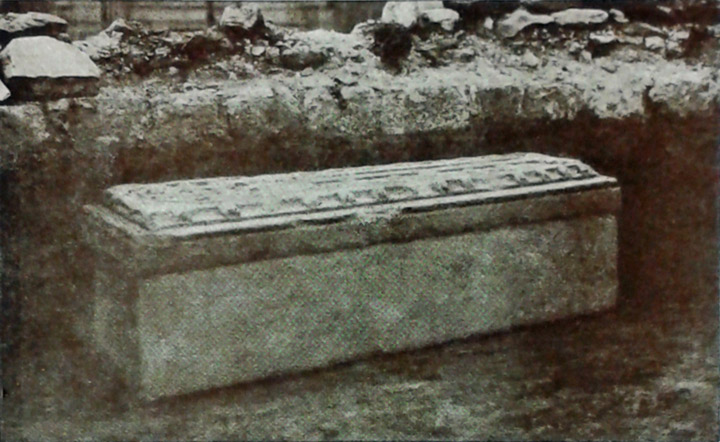
It would have been pleasant had it been possible to leave it in its original
position but there it would soon have suffered from exposure to the weather
while the Scottish urchin has little respect for beautiful objects and nowadays
very little dread of the consequences of destroying things.
The
next most appropriate place would have been the present successor of the ancient
parish church but this does not seem to
have been thought of and the coffin and its lid are in safe and honourable - if
no longer sacred - keeping in their present resting place in the vestibule of
the Municipal Buildings.
Thither
we went to view it and there we were courteously received by the Provost and the
bailies.
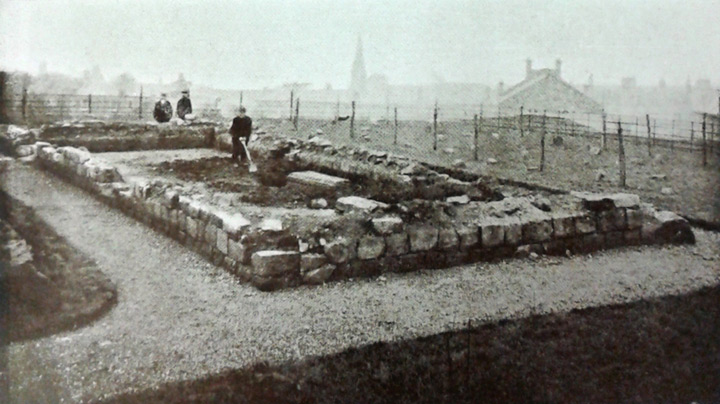
Our next visit was to the new Parish Church of Ardrossan in Saltcoats where we
were received by the minister, the Reverend D D Rees and prayers were said.
The
church is one of the finest of those wherewith Mr Peter MacGregor Chalmers has
enriched Scotland. Thereafter,
the company was hospitably entertained in the Parish Church Hall.
Transactions of the Scottish
Ecclesiological Society, 1913
, volume 4
The Scottish
Ecclesiological Society preferred that the sarcophagus was housed in ‘the
present successor of the ancient parish church’, namely Saint Cuthbert’s Church
in Saltcoats, then – and now – the fourth parish church of Ardrossan.
The Church, at the junction of Caledonia Road and Campbell Avenue is
shown below.

STATEMENT
BY MRS HUNTER, SPIRITUALIST, SALTCOATS
On 13 October 1913, Mrs Hunter, a Spiritualist from
Saltcoats, gave a statement to James C Duncan, Burgh Surveyor for Ardrossan Town
Council.
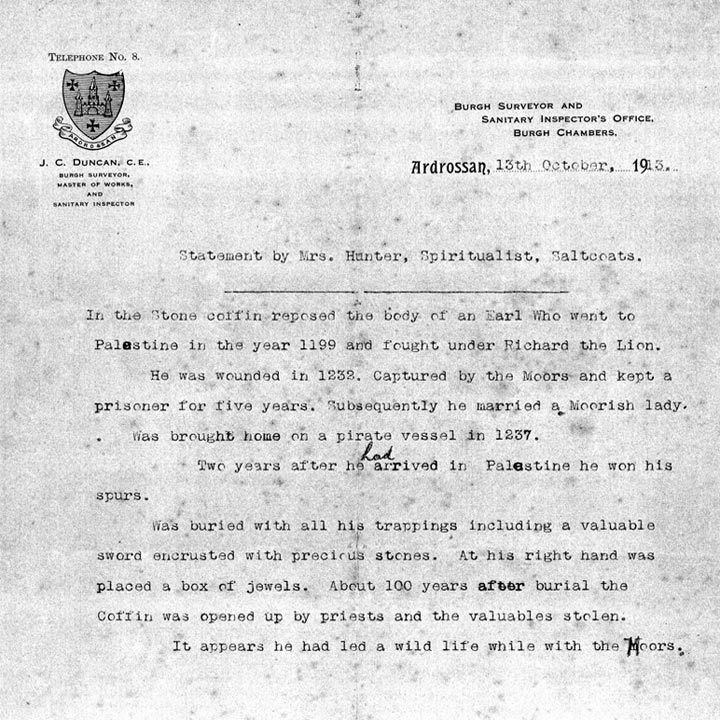
The letter is reproduced above with the kind permission of North Ayrshire
Heritage Centre and its text is given below.
In the stone
coffin reposed the body of an Earl who went to Palestine in the year 1199 and
fought under Richard the Lion.
He was wounded in 1232.
Captured by the Moors and kept a
prisoner for five years.
Subsequently he married a Moorish
lady.
Was brought home on a private vessel
in 1237.
Two years after he had arrived in
Palestine he won his spurs.
Was buried with all his trappings
including a valuable sword encrusted with precious stones.
At his right hand was placed a box of
jewels.
About 100 years after burial the
coffin was opened up by priests and the valuables stolen. It appears he had led
a wild life while with the Moors.
13 October 1913
DEATH
OF ROBERT COOK
Robert Cook, the man who unearthed the Ardrossan Sarcophagus in
1911, died on 5 June 1931 at 1 Hill Place, Ardrossan.

Ardrossan and Saltcoats Herald, 12 June 1931
1 Hill Place is less than 200 yards from
where Robert found the coffin.
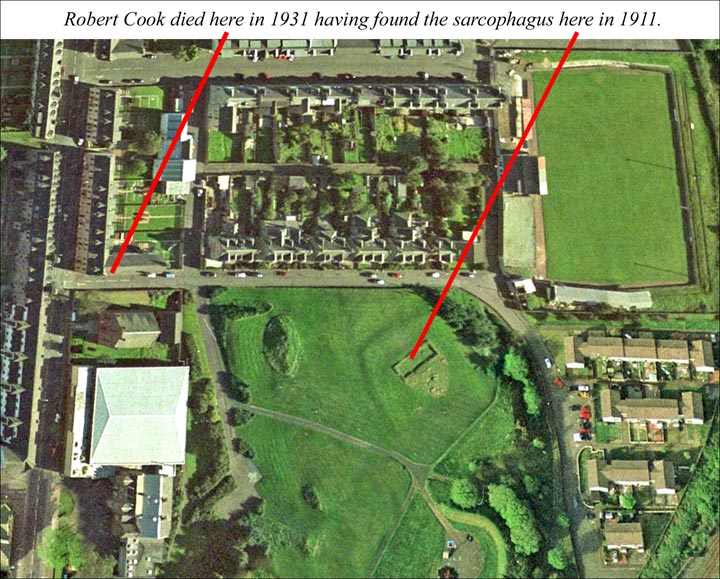
It might be expected that Robert Cook would
be buried in Ardrossan Cemetery but this is not the case.
He was interred on 8 June 1931 in Maybole Cemetery in the town
of his birth, beside his wife, Bessie, who died in 1924 and his son, Angus, who
died in 1895.
OPENING OF THE CHURCH OF SAINT PETER IN CHAINS
On 2 October 1938, a replacement Catholic Church
was opened in Ardrossan.
It lies 280 yards due south of the Castle Hill Church.
In memory of the altar in the old church to Saint Peter in
Bonds, the new Church was called the Church of Saint Peter in Chains.

Two
hundred yards from where Mass was last celebrated three hundred and fifty years
ago for the fisher folk of Ardrossan, a new church dedicated to Saint Peter in
Chains was solemnly opened by Archbishop Mackintosh on Sunday last (2 October
1938).
Since the Reformation Ardrossan had been denied a
Catholic church, but once again, almost in the shadows of Castle Hill where the
sad, neglected ruins of the old church of Saint Peter in Chains still stand, the
Holy Sacrifice of the Mass has been celebrated.
Glasgow Observer and Catholic Herald, 7 October 1938
ARCHAEOLOGY
NOTES BY THE ROYAL COMMISSION ON THE ANCIENT AND HISTORICAL MONUMENTS OF
SCOTLAND
Ardrossan church originally stood within its churchyard on Castle Hill.
Its foundations arestill visible.
It
was blown down by a violent storm in 1691, when it was replaced by the church
described on NS24SW 6.
In it were altars to Saint Peter and the
Virgin Mary. It
was excavated in 1911 when it was shown to be a long, oblong building , its
chancel of the same width as the nave, above which it was raised by three low
steps, placed at wide intervals.
Considerable
areas of stone paving remained. A stone coffin, with a carved lid, was found
within the church, near the north wall.
It
was removed to the vestibule of the Municipal Buildings.
A
thirteenth century date is suggested for it.
1950
NS24SW 6 refers to an RCAHMS document on Kirkhall
Burial Ground off Stanley Road, Ardrossan.
In 1697, Ardrossan Parish Church was rebuilt
at Stanley Clachan, near what is now the junction of Stanley Road and Saint
Andrew’s Road. The Archaeology
Notes recorded the excavation year as 1912 but there is considerable evidence to show that
it was 1911.
SALTCOATS TOWN COUNCIL INTERESTED IN HAVING
THE ARDROSSAN SARCOPHAGUS

Reference was made to the ancient stone coffin presently in the custody of the
Ardrossan Town Council which it is understood the
Ardrossan
Town Council desired to have removed from their Council Chambers.
It was resolved that the Clerk be instructed to write to Ardrossan Town Council
and to request that this stone coffin should eventually be made over to the
Saltcoats Town Council as an exhibit in their proposed Museum when such a Museum
should be set up.
Meantime, Ardrossan Town Council should be
requested to have in mind, when disposing of the coffin, the claim of the
Saltcoats Museum to the eventual custody thereof.
Minutes of the Meeting of Saltcoats
Town Council, 11 September 1950
THREE
PARTIES EXPRESS INTEREST IN THE ARDROSSAN SAROPHAGUS
Consideration was resumed of the disposal of the
stone coffin at present in the Burgh Chambers.
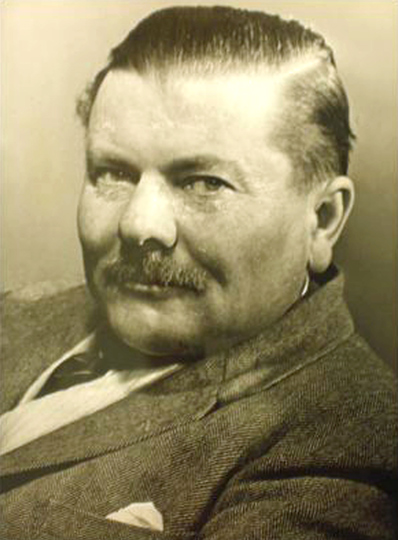
A
letter dated 30 July last was submitted from the Right Honourable The Earl of
Eglinton, shown above, suggested that the coffin might be placed in the
Skelmorlie Aisle at Largs which was an old burial place of the Montgomeries of
Skelmorlie and was preserved by the Ancient Monuments Board. A letter
dated 8 October was submitted from the Minister of Ardrossan Barony Church,
shown below as Barony Saint John’s Church in 2015 then disused, stating that
the
Church would be prepared to accept custody of the coffin and to house it in the
vestibule of the Barony Church where it
could be accommodated.
It was agreed to accept the offer of the
Barony Church to accommodate the coffin and it was agreed to get an estimate of
the cost of its removal and installation in time for the next meeting of the
Finance Committee.
It was remitted to the Convenor of this
Committee and the Burgh Surveyor to see to the transport and lodgement of the
coffin.
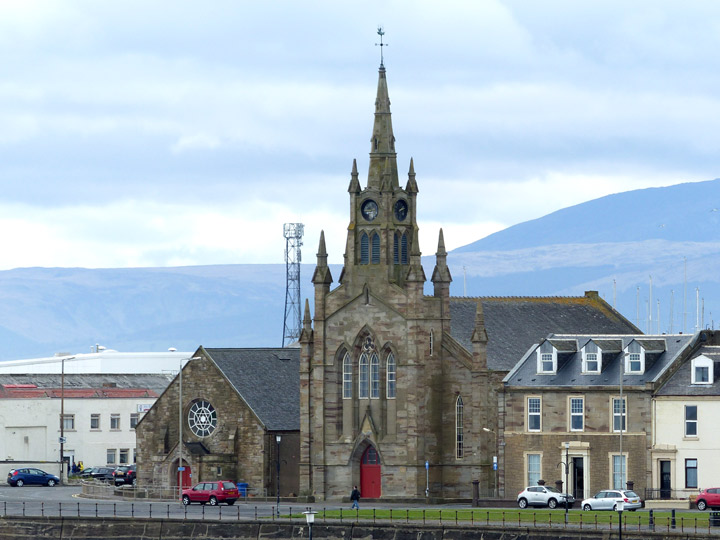
Minutes of the Meeting of Ardrossan
Town Council, 25 October 1950
STONE COFFIN
The Burgh Surveyor reported that the
stone coffin had been removed from the
Burgh Chambers to the vestibule of the Barony Church on 9 November.
Minutes of the Meeting of Ardrossan
Town Council, 13 November 1950
ARCHAEOLOGY NOTES
The foundations of this church can be traced,
measuring 19.5 by 7.8 metres (64 feet by 25 feet 7 inches).
The
grass-covered floor lies 0.5 metre (1 foot 8 inches) below the top of the wall,
which is 0.2 metre (8 inches) high externally and 0.9 metre (2 feet 11 inches)
broad. The masonry is of ashlar.
There
appear to be two entrances in the south wall, each having a step leading down in
to the interior. There
are also two small breaks in the north wall.
Their purpose could not be ascertained as they
seemed too narrow for doorways.
The churchyard wall has been removed and the
whole area is an open park.
A
few gravestones still exist, one dated 1662 and some of eighteenth century date.
Royal Commission on the Ancient
and
Historical Monuments of Scotland (RCAHMS),
7 September
1956
OPENING OF NORTH AYRSHIRE
MUSEUM, SALTCOATS
On 25 June 1957, the North Ayrshire Museum, later
North Ayrshire Heritage Centre, opened in Saltcoats on the initiative of Owen
Kelly.
The sarcophagus was not listed among the exhibits named in newspaper reports on
the opening ceremony implying that it was not in the Museum on its opening day.

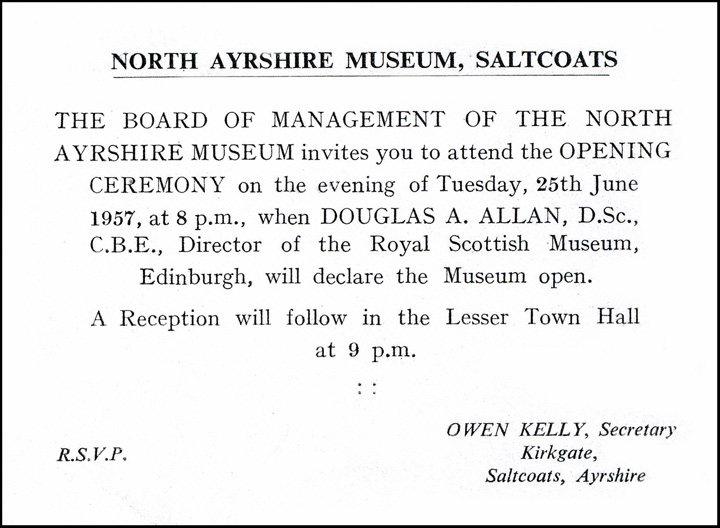
SARCOPHAGUS TAKEN TO NORTH AYRSHIRE MUSEUM
The coffin was taken to the Museum in 1958 according to a story, to be included
later, in the Ardrossan and Saltcoats Herald of 2 December 2005.
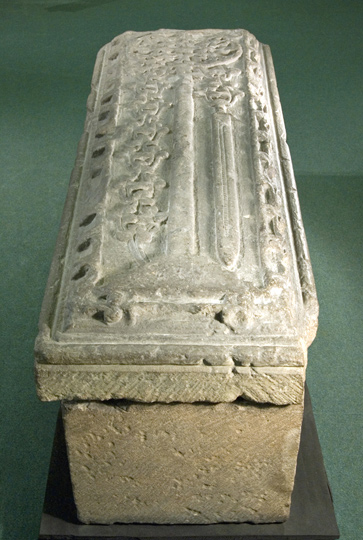

COFFIN CARTOON
The cartoon below dates from the late 1950s or early 1960. Its origin
is unknown.
Late 1950s or early 1960s
The Owen referred to is Owen Kelly who founded the North Ayrshire
Museum, later North Ayrshire Heritage Centre.
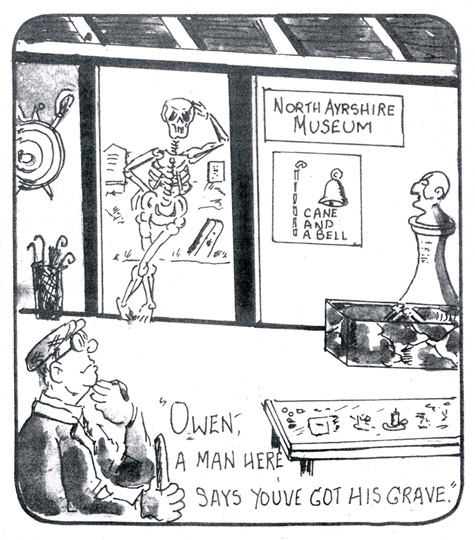
ARCHAEOLOGY NOTES
No change to the previous
report. The stone coffin is now
displayed in the North Ayrshire Museum, Saltcoats, together with
leather fragments of a possible sandal
said to have been found within the coffin.
No accession or catalogue numbers.
Royal Commission on the Ancient
and
Historical Monuments of Scotland (RCAHMS),
13 October
1982
This is the only
document that suggests that the leather may be from a sandal.
As stated previously, it feels soft like suede and is pliable
without the rigidity of modern shoe leather.
SCOTTISH CULTURAL RESOURCES ACCESS NETWORK (SCRAN)
SCRAN is a
charitable online learning service with nearly half a million images and other
media from museums, galleries and archives.
It is based in Edinburgh and was
formed in 1996 for ‘the advancement of education by enabling public access to
Scottish cultural resources and related material’.
SCRAN has a photograph of the
sarcophagus with the annotation below.
The coffin was found in
1911 during excavations of the pre-Reformation Ardrossan Parish Church.
It would most (likely) have been made by a
French mason working on the construction of Kilwinning Abbey during the late
twelfth and early thirteenth centuries. The base of the coffin is hollowed
out in the shape of a man and the lid is decorated with an ornate Celtic cross,
fleur-de-lys border and a sword.
The sword identifies it as the last resting
place of a Knight Templar.
The Knights of the Temple of Solomon were
formed in 1128 to protect pilgrims journeying to Palestine after the First
Crusade.
They became a powerful force in Europe and were
eventually suppressed in 1312 by Philip IV of France and Edward II of England.
Scottish Cultural Resources Access Network, 1996


































